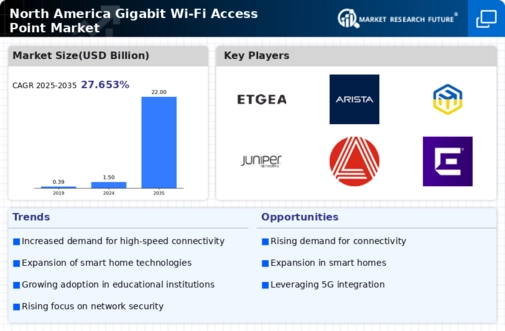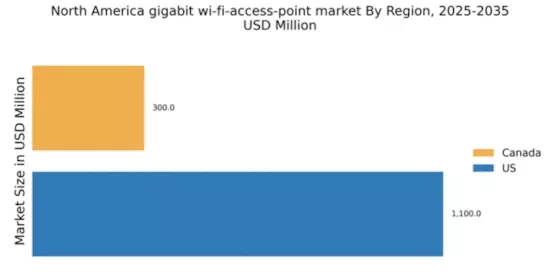The gigabit wi-fi-access-point market is characterized by a dynamic competitive landscape, driven by the increasing demand for high-speed internet connectivity across various sectors. Key players such as Cisco Systems (US), Aruba Networks (US), and Netgear (US) are at the forefront, each adopting distinct strategies to enhance their market positioning. Cisco Systems (US) emphasizes innovation through continuous investment in research and development, focusing on advanced security features and seamless integration with existing network infrastructures. Meanwhile, Aruba Networks (US) leverages its strong presence in enterprise solutions, aiming to expand its footprint in the education and healthcare sectors, which are increasingly reliant on robust wireless connectivity. Netgear (US) appears to be concentrating on consumer markets, offering affordable yet high-performance solutions that cater to the growing number of remote workers and smart home users. Collectively, these strategies contribute to a competitive environment that is both collaborative and competitive, as companies seek to differentiate themselves through technology and service offerings.
In terms of business tactics, companies are increasingly localizing manufacturing and optimizing supply chains to enhance responsiveness to market demands. The competitive structure of the market is moderately fragmented, with several players vying for market share. This fragmentation allows for a diverse range of products and services, catering to various customer needs. However, the influence of key players remains substantial, as they set industry standards and drive technological advancements that smaller companies often follow.
In October 2025, Cisco Systems (US) announced a strategic partnership with a leading cloud service provider to enhance its wi-fi access point offerings. This collaboration aims to integrate cloud-based management solutions, allowing customers to manage their networks more efficiently and securely. The strategic importance of this move lies in Cisco's ability to leverage cloud technology, which is increasingly becoming a critical component of modern networking solutions, thereby enhancing its competitive edge.
In September 2025, Aruba Networks (US) launched a new line of gigabit wi-fi access points designed specifically for high-density environments, such as stadiums and conference centers. This product line aims to address the growing need for reliable connectivity in crowded spaces, where traditional solutions often falter. The introduction of these specialized products indicates Aruba's commitment to innovation and its understanding of evolving customer requirements, positioning the company favorably in a competitive market.
In August 2025, Netgear (US) expanded its product portfolio by introducing a series of mesh wi-fi systems that cater to both residential and small business users. This strategic move not only broadens Netgear's market reach but also aligns with the increasing consumer preference for seamless connectivity throughout larger spaces. By focusing on user-friendly solutions, Netgear is likely to strengthen its market position and appeal to a wider audience.
As of November 2025, current competitive trends in the gigabit wi-fi-access-point market include a strong emphasis on digitalization, sustainability, and the integration of artificial intelligence (AI) into networking solutions. Strategic alliances are increasingly shaping the landscape, as companies recognize the value of collaboration in driving innovation and enhancing service delivery. Looking ahead, competitive differentiation is expected to evolve, with a notable shift from price-based competition to a focus on technological innovation, reliability, and supply chain efficiency. This transition underscores the importance of not only meeting customer demands but also anticipating future needs in a rapidly changing digital environment.


















Leave a Comment